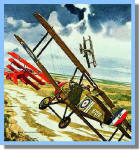Capt. Roy Brown, DSC.
(Thumbnail will enlarge when clicked upon. To return to the page you are viewing then click on your browser's "Back" button).
Fifty feet above the Somme River, time ran out on the life of Manfred von Richthofen, Germany's greatest ace. Behind his red Fokker was Captain Roy Brown in a British-built Sopwith Camel.
The Canadian was low on ammunition, but began firing as soon as he was within range -- and the treacherous Camel claimed another victim.
When this stubby fighter was first introduced in 1917, it took more lives of Royal Flying Corps pilots than the Germans did. As the War progressed, the Camel chalked up an outstanding record of enemy kills: 1,6344 confirmed victories, including 99 balloons and a Zeppelin. Although the plane became the supreme Allied dogfighter of the war, only one Victoria Cross was won by a Camel pilot.
The Camel was the favorite plane of many unsung British heroes. One of them was Captain H. W. Woollett, D.S.O., M.C. On April 12, 1918, Captain Woollett shot down three enemy aircraft before lunch, then scored victories over a Pfalz D111, a 2-seater reconnaissance plane, and a Fokker Triplane -- a feat seldom equaled and never surpassed.
The Camel demanded courage and intelligence of its pilots. For high maneuverability, its main weight was concentrated in a short forward fuselage. Its biplane wings spanned only 28 feet; the upper wing was mounted flat and the bottom wing had a high degree of dihedral.
The Sopwith Camel flew for 15 months with the Royal Flying Corps and the Royal Naval Air Service. The plane derived its name (at first unofficially) from the humping of the panels which faired the breeches of it twin Vickers guns. The prototype had a 110-h.p. Clerget engine. Production machines had a more powerful 130-h.p. Version and some had a 110-h.p. Le Rhone. Although the plane has been described as "too slow to catch anything or to run away," it had more speed than the Fokker Triplane.
Its rotary engine had the effect of a 381-pound gyroscope. Pilots encountered their first problem with the Camel just after take-off; correct setting of the fine adjustment with the throttle. If the mixture was not right, the engine would cut out at about 200 feet, and the plane would head into a spin.
The Sopwith camel saw extensive service against ground installations and troops. It was equipped to carry four-25-pound fragmentation bombs, and more venturesome pilots also added a lapful of grenades to increase the plane's armament. Some pilots removed the fairing strips from the brace wires between the wings to add a scream to the normal whine of the engine during strafing operations. The Camel was among the first planes used on Royal Navy carriers and also was used extensively in night flying operations.
The British built 5,490 Sopwith Camels. All were treacherous to handle and full of idiosyncrasies -- but their unmatched maneuverability and lighting-fast turns contributed importantly to aerial supremacy.
"The Killer Camel" is from the "Heritage of the Air Collection" by Merv Corning, used with permission of Leach International Corporation, Buena Park, CA. In no event may these pictures be reproduced or used for commercial purposes.
Please follow the Barker link to see more of Canada's World War 1 Aces:



